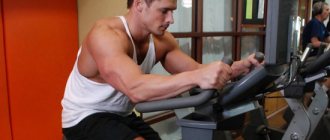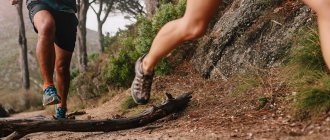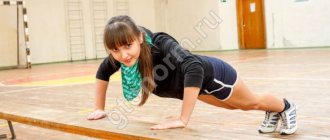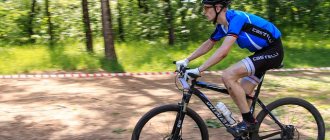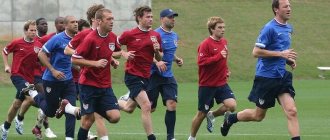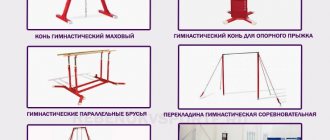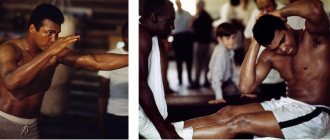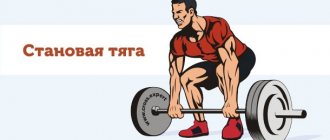tags:
Physical, Sports, Development, Load, Fitness, Preparation, For example, Fitness
Physical fitness
is the capabilities of the body's functional systems. It reflects the required level of development of those physical qualities on which competitive success in a particular sport depends.
Physical preparedness as a component of sports readiness in the explanatory dictionary of sports terms defines the concept of sports readiness as “the state of an athlete acquired as a result of preparation (physical, technical, tactical, mental), allowing to achieve certain results in competitive activity.” We also read there that “physical training is one of the aspects of training in physical education and sports, associated with the development of physical qualities (strength, speed, endurance, flexibility and coordination abilities).” K.L. Chernov defines sports preparedness as “a connected system of knowledge, abilities, skills, qualities, properties of functional systems that determine the level of a person’s qualifications in a certain profession.” Yu.I. Smirnov interprets sports readiness as “a complex result of training, expressed in an increased level of functional capabilities of the athlete’s body, his specific and general performance, in the achieved degree of perfection of sports skills, abilities and sports knowledge.” Many authors agree with their opinion and consider sports results to be the true criterion of sports readiness.
At the same time, they note that a sports result, and, consequently, sports readiness, is a multifactorial phenomenon in which many components, including physiological ones, have significant weight, which especially applies to sports with a predominant manifestation of endurance. A number of authors add that in a state of peak athletic performance, some physiological indicators do not correspond to their maximum values. The term “fitness” is very close in meaning to the concept of “physical preparation”, i.e. “a state of the body that determines the level of physical fitness of an athlete, which is a consequence of training.” Fitness is a complex medical and pedagogical concept that characterizes an athlete’s readiness to achieve high sports results. Its level depends on the effectiveness of the structural and functional restructuring of the body, which is combined with the high technical, tactical and psychological preparedness of the athlete. Currently, the leading role in diagnosing fitness belongs to the coach, who carries out a comprehensive analysis of medical-biological, pedagogical and psychological information about the athlete. Consequently, training determines the physical fitness of the athlete, which, in turn, is an integral part of sports readiness.
3 pages, 1347 words
Presentation on the topic: Mind and body
... (predominance of digestion) mesomorphic somatotonics (predominance of physical activity) ectomorphic cerebrotonics (predominance of brain activity) Influence of gender... monitor several processes simultaneously), switching. a) natural, associated with self-regulation of the body (involuntary); b) socially conditioned, associated with upbringing and training (...
But the connection between these concepts is much more complex than it might seem at first glance. So there is an opinion among experts that in sports there is no general fitness, therefore, there are no indicators of general physical fitness, therefore sport is characterized by indicators of special physical fitness. Other authors argue that the concept of general fitness cannot be abandoned, since it is precisely this that is the necessary basis for special preparedness. ON THE. Bernstein and V.M. Zatsiorsky determine fitness by assessing motor performance and the effectiveness of technique in conjunction with morphological characteristics. V.A. Zaporazhanov, V.M. Zatsiorsky, BC Farfel believe that fitness is an intuitive concept that does not have clear measurements. For educational and training purposes, for the selection of means and loads, for the further growth of sportsmanship, an assessment of many components that make up sports readiness is also necessary, including those determined by external conditions and influences. The number of components of one athlete’s preparedness is very large and difficult to fully analyze. The components of sports readiness taken into account today consist of many other components also of different significance.
N.G. Ozolin determines 20 types of sports readiness, each of which corresponds to 4 components. In our study, the following types of sports readiness are of particular interest: physical, general physical, general functional, special physical, special functional, special muscle strength, special speed (speed) of movements, special endurance. In addition to the above components, there are also theoretical, technical, tactical, psychological, volitional, integral and other types of sports preparedness. The author claims that they are all “interconnected and manifest themselves as numerous morphoanatomical, physiological, biochemical and motor capabilities of a single organism. When determining these components, two groups should be distinguished: one, determined to a greater extent by genetic prerequisites, and the other, depending on the degree of training.” Among all the components of sports readiness, the author distinguishes “leading ones - those that increase in the process of preparation; supporting - reaching a certain level and stopping there; providing - creating psychological, physiological and biochemical opportunities for the manifestation of leading and supporting components.”
When determining the significance of the components of sports readiness N.G. Ozolin, like many other experts, recommends using the factor analysis method, “in which, through multiple correlation, a connection is established between each component and a sports result.” In a number of works, specialists and scientists identify its constituent parts in the structure of sports readiness, which, according to the degree of importance, are located at three levels. The first includes the characteristics of competitive activity, determined as a result of regular long-term collection of information during competitions. At the second level, the characteristics of the special physical, technical and tactical readiness of athletes are highlighted. At the third level, the characteristics of functional and mental preparedness, morphological features, age, sports experience, etc. are considered.
63 pages, 31056 words
General and special physical training of freestyle wrestlers 16–17 years old
... physical training presupposes the diversified development of physical qualities, functional capabilities and systems of the athlete’s body, the coherence of their manifestation in the process of muscular activity. In modern sports training, general physical fitness ... 1. Methods and means of training freestyle wrestlers On the topic “General and special physical training of freestyle wrestlers 16-17 ...
Physical training (concept, goal, objectives, principles)
Sports preparation (training) is the appropriate use of knowledge, means, methods and conditions, which allows for a targeted influence on the development of an athlete and ensures the necessary degree of his readiness for sports achievements. Currently, sport is developing in two directions with different target orientations - mass sport and elite sport. Their goals and objectives differ from each other, but there is no clear boundary between them due to the natural transition of some trainees from mass sports to “big” sports and back.
The goal of sports training in the field of mass sports is to strengthen Health, improve physical condition and active recreation.
The goal of training in the field of elite sports is to achieve the highest possible results in competitive activities. However, as for the means, methods, and principles of sports preparation (training), they are similar both in mass sports and in elite sports.
Competitive training method
It is used both in relatively elementary forms (a way to stimulate interest and activate students when performing a separate exercise in the classroom), and in independent form as a test or official sports competition. The main feature of the competitive method is the comparison of the strengths of those involved in conditions of orderly competition for superiority or high achievement. The competitive method is used to solve a variety of pedagogical problems. This is, first of all, the improvement of skills in difficult conditions for the development of physical, moral and volitional qualities. The factor of rivalry in the process of competition creates a special emotional and physiological background, which significantly enhances the impact of physical exercise and contributes to the maximum manifestation of the body's functional capabilities. This method must be used after special preliminary preparation.
General physical training (GPP)
helps to increase functional capabilities, overall performance, and is the basis (base) for special training and achieving high results in a chosen field of activity or sport. The following tasks may be assigned to the general physical training program:
• achieve harmonious development of body muscles and corresponding muscle strength;
• acquire general endurance;
• increase the speed of performing various movements, general speed abilities;
4 pp., 1869 words
The influence of physical activity on the psychological state of students
... The influence of physical activity on the psychological state of students The influence of physical activity on ... social effects (health, physical development, physical fitness, features of mental self-regulation, ... physical education have shown that feelings of joy, excitement, satisfaction are more often experienced from sports activities ... the general tone of the cerebral cortex brain, as a result of which its overall...
• increase the mobility of the main joints, muscle elasticity;
• improve dexterity in a wide variety of (domestic, work, sports) activities, the ability to coordinate simple and complex movements;
• learn to perform movements without unnecessary stress, master the ability to relax.
General training principles:
- consciousness and activity, visibility,
- availability,
- systematicity,
- dynamism.
However, in the field of physical education and, in particular, in the field of sports training, these principles are specified and filled with content that reflects the specifics of the process.
The principle of accessibility - uh
This principle obliges us to strictly take into account age and gender characteristics, level of preparedness, as well as individual differences in the physical and mental abilities of those involved.
Accessibility does not mean the absence of difficulties in the educational and training process, but presupposes a feasible measure of these difficulties that can be successfully overcome. Most often, the entire group is given tasks of average complexity, accessible to the “middle part” of students (frontal approach).
The negative side of this approach is that the strongest part of the group works in easier conditions, and the weakest in more difficult conditions.
As the teacher becomes more familiar with the study group, he increasingly uses the so-called group approach,
when microgroups within the study group are determined according to the degree of their preparedness for a specific task.
The principle of systematicity -
This is, first of all, regularity of classes, rational alternation of loads and rest. Regularity of classes involves a rational alternation of psychophysical stress and rest. Any load has four phases: energy consumption, recovery, super-recovery, return to baseline. It is necessary, however, to take into account that if the training session is followed by too long a break, then this effect is gradually lost to one degree or another (reduction phase).
Repeatability and variability in the use of various exercises and tasks in optimal time periods are also mandatory components of the principle of continuity.
The principle of dynamism
, or gradual increase in requirements, consists in setting increasingly difficult tasks as the previous ones are completed. This is expressed in the gradual complication of motor tasks, in an increase in the volume and intensity of loads (subject to the principle of accessibility).
When implementing the principle of dynamism, it is planned to regularly update educational material, as well as increase the volume and intensity of loads. Straightforward
increasing loads is used when their overall level is relatively low and you need to gradually get involved in work.
Stepped
the dynamics sharply stimulate training based on the work already done.
wavy
fluctuations in loads in weekly, monthly, annual cycles are a kind of background on which linear and stepwise dynamics are superimposed.
6 pages, 2789 words
INDEPENDENT MOTOR ACTIVITY AS A MEANS OF MOTOR...
... directions of physical education and propose new approaches to assessing the motor development of preschool children, based on the results of many years of research. Preschool age is the period of the most rapid development of the structure and functions of the child’s body. ...
Force
You will be interested in: Development and life cycle of roundworms: stages, sequence of processes
This refers to the muscle's ability to overcome resistance. Assessment of physical fitness in this case is also carried out in several areas:
Physical activity (general characteristics, basic requirements)
Three types of physical activity: static, in which there is prolonged tension in individual muscle groups (for example, a forced working position in which you have to spend a certain time), dynamic, when tension and relaxation alternate in muscle groups (for example, walking, running, swimming) and “explosive”, characterized by very strong and short-term muscle tension (for example, lifting weights).
There are, in addition, mixed types, as well as physical inactivity (absence of any types of loads, with the exception, of course, of minimal muscle activity).
We will begin our analysis with dynamic types of load, then it will be easier for us to analyze other types.
Dynamic loads can be of low, medium and high intensity. What happens in the body under low dynamic load (for example, when walking)? Working muscles require more oxygen, so the heart strengthens its contractions and increases their speed.
“Explosive” loads are the most unfavorable in their effect on the heart. The demands placed on the heart in this case include the need to ensure significant muscle tension (for example, when lifting a barbell) and combine both a mechanism of static tension, when blood flow in tense muscles is disrupted (and the so-called afterload on the heart increases - i.e. , the need for the heart to push blood through compressed vessels with enormous effort), and the mechanism of dynamic work performance (the barbell still needs to be lifted), when increased muscle contraction causes an avalanche-like energy consumption and a decrease in the content of energy-accumulating substances (for example, ATP).
Even despite the short duration of the “explosive” loads, the heart experiences serious overload. A sharp increase in voltage from “zero” to almost maximum causes a significant increase in the heart’s need for oxygen and a deterioration in coronary blood flow, a sharp release of adrenal hormones (adrenaline, etc.), which in repeated situations can lead to changes in the adrenal glands, an increase in sugar and cholesterol in blood, increased blood pressure and excessive load on the vessels, which under certain conditions can lead to the rupture of one or another blood vessel (and, accordingly, to a heart attack, stroke, etc.), disruption of adaptive autonomic mechanisms, which can cause, among other things, disruption of the normal functioning of internal organs.
Rules for monitoring and dosing physical activity
Excess body weight, decreased physical performance, smoking, excessive alcohol consumption - all this contributes to the occurrence of cardiovascular and many other diseases. Despite the powerful development of drug therapy, dosed physical activity remains a universal method for the prevention of coronary heart disease, arterial hypertension, obesity and other diseases. Recently, there has been a certain increase in the population's interest in regular physical education. Physical activity is practically safe for people with an initially good level of physical health, who have undergone a full medical examination and received adequate medical recommendations. Physical fitness can be characterized as the body’s ability to comfortably endure everyday physical activity and successfully cope with suddenly occurring stressful situations. The individual level of physical performance is influenced by factors such as age, gender, heredity, bad habits, and nutritional patterns. The concept of physical health, or fitness of the body, includes several components. The duration and number of workouts per week, as well as the intensity of physical activity, are determined by the level of fitness of the body, age, the presence or absence of any chronic diseases, as well as the social needs of the person. Any individual training program should include exercises aimed at the harmonious development of all the main components of physical health. Any training session should consist of a warm-up (warmup), main load and cool-down (cooldown).
4 pp., 1986 words
Aesthetic education in the development of a child with intellectual disabilities
... components of development, highlighting the physical, mental, spiritual, social and other aspects. The essence of the pedagogical process is to ensure the unity of training, education and development. Correlation... established definitions, we come to the conclusion that development is the process and result of quantitative and qualitative changes in the human body. It is associated with constant...
Below is the structure of a training session, designed for the average healthy person and aimed at maintaining a minimum level of physical health of the body. It includes the most popular types of training exercises. Warm-up lasts five to ten minutes and includes low-intensity physical activity (walking, slow running, flexibility exercises, rotational and swinging movements of the upper and lower extremities).
It is aimed at preparing the cardiovascular, respiratory and musculoskeletal systems for the main training load. Below are the main types of core training load. Training to develop muscle strength (muscular strength) is carried out at least twice a week for 20 minutes. The most effective way to develop muscle strength is to lift weights. Training to develop muscular endurance should be carried out at least three times a week for 30 minutes and include exercises for the main muscle groups: rhythmic and plastic exercises, push-ups, squats, pull-ups, repeated weight lifting. Training to develop fitness of the cardiovascular and respiratory systems (cardiorespiratory endurance) is carried out three times a week for 20 minutes and includes prolonged physical activity performed in an aerobic mode. The most common types of such exercise are fast walking, running, cycling, rowing, skiing, as well as team sports (basketball, handball, etc.).
Flexibility training should be done daily during the warm-up or cool-down and include flexibility and stretching exercises. A cooldown involves low-intensity activity (such as walking or running at a slow pace) and five to ten minutes of flexibility exercises.
Physical qualities (general characteristics)
Physical qualities are understood as socially conditioned sets of biological and mental properties of a person, expressing his physical readiness to carry out active motor activity. The main physical qualities include strength, endurance, agility, flexibility, etc. Physical qualities differ from other personality traits in that they can only manifest themselves when solving motor problems through motor actions. Motor actions used to solve a motor task can be performed differently by each individual. Some have a higher rate of execution, others have a higher accuracy of reproducing movement parameters, etc. Physical abilities are understood as relatively stable, congenital and acquired functional capabilities of organs and structures of the body, the interaction of which determines the effectiveness of performing motor actions. Innate capabilities are determined by the corresponding inclinations, acquired ones - by the socio-ecological environment of a person’s life. At the same time, one physical ability can develop on the basis of different inclinations and, conversely, different abilities can arise on the basis of the same inclinations. The realization of physical abilities in motor actions expresses the nature and level of development of the functional capabilities of individual organs and structures of the body. Therefore, a single physical ability cannot fully express the corresponding physical quality. Only a relatively constantly manifested set of physical abilities determines this or that physical quality. For example, one cannot judge endurance as a physical quality of a person if he is able to maintain running speed for a long time only at a distance of 800 m. We can talk about endurance only when the totality of physical abilities ensures long-term maintenance of work with all the variety of motor modes of its implementation. The development of physical abilities occurs under the influence of two main factors: the hereditary program of the individual development of the organism and its socio-ecological adaptation (adaptation to external influences).
20 pp., 9935 words
Studying the influence of physical education on the correction...
... retarded schoolchildren by means of physical education 1.1. Specific features of the motor analyzer of mentally retarded schoolchildren To solve many problems of physical education in school VIII ... mentally retarded schoolchildren by means of physical education, an analysis of 60 theoretical sources is given, the features of the development of the motor analyzer of mentally retarded schoolchildren are highlighted, ...
Because of this, the process of development of physical abilities is understood as the unity of hereditary and pedagogically guided changes in the functional capabilities of organs and structures of the body. The presented ideas about the essence of physical qualities and physical abilities allow us to conclude: a) the basis of the education of physical qualities is the development of physical abilities. The more developed the abilities that express this physical quality, the more consistently it manifests itself in solving motor problems; b), the development of physical abilities is determined by innate inclinations that determine the individual capabilities of the functional development of individual organs and structures of the body. The more reliable the functional interaction of organs and structures of the body, the more stable the expression of the corresponding physical abilities in motor actions; c) the education of physical qualities is achieved through the solution of various motor tasks, and the development of physical abilities - through the performance of motor tasks. The ability to solve diverse motor tasks characterizes the comprehensiveness of the education of physical qualities, and the ability to perform diverse motor actions with the necessary functional activity of the organs and structures of the body speaks of the harmonious education of physical qualities.
11 pages, 5306 words
Development of physical qualities of children of primary school age...
... rest, strengthening or restoring health, maintaining and increasing performance, developing physical qualities, improving motor skills [5,6]. These include: -Small forms of classes; ... predominant and performs the main function in solving problems of all categories of physical education (educational, physical development). Depending on the content of the lesson, its structure is ...
Quickness (aka speed)
This indicator is used to characterize the fastest possible alternation of states of muscle contraction and relaxation. They highlight sprinting speed, movements and reactions. To determine the first indicator, the time it takes a person to cover 25 meters on the move is used. The speed of movement shows the level of adaptability to the various actions that need to be performed. For example: shuttle running, moving up stairs for a while, etc. Reaction speed indicates how quickly a person reacts to certain external stimuli.
The process of physical education at a university (goal, objectives, forms)
The goal of physical education in universities is to promote the preparation of harmoniously developed, highly qualified specialists. In the process of studying at a university in the course of physical education, the following tasks are envisaged: nurturing in students high moral, volitional and physical qualities, readiness for highly productive work; maintaining and strengthening the health of students, promoting the proper formation and comprehensive development of the body, maintaining high performance throughout the entire period of study; comprehensive physical training of students; professional - applied physical training of students, taking into account the characteristics of their future work activity; acquisition by students of the necessary knowledge on the basics of theory, methodology and organization of physical education and sports training, preparation for work as public instructors, coaches and judges; improving the sports skills of student athletes; instilling in students the conviction of the need to regularly engage in physical education and sports.
The learning process is organized depending on the health status, level of physical development and preparedness of students, their sports qualifications, as well as taking into account the conditions and nature of work of their upcoming professional activity. One of the main tasks of higher educational institutions is the physical training of students.
Forms of physical education for students. Physical education at a university is carried out throughout the entire period of students’ education and is carried out in diverse forms that are interconnected, complement each other and represent a single process of physical education of students. Classes are the main form of physical education in higher education institutions. They are planned in the curricula for all specialties, and their implementation is ensured by teachers of the departments of physical education. Independent studies contribute to better assimilation of educational material, allow you to increase the total time of physical exercise, accelerate the process of physical improvement, and are one of the ways to introduce physical culture and sports into the life and leisure of students. In conjunction with educational activities, properly organized independent activities ensure optimal continuity and effectiveness of physical education. These classes can be conducted outside of class time on the instructions of teachers or in sections. Physical exercises in the daily routine are aimed at strengthening health, increasing mental and physical performance, improving the conditions of educational work, life and recreation of students, increasing the time budget for physical education. Mass recreational, physical education and sports events are aimed at broadly attracting students to regular physical education and sports, promoting health, and improving the physical and sports preparedness of students. They are organized during free time from classes, on weekends and holidays, in health and sports camps, during educational practices, camp meetings, and in student construction teams. These events are held by the university’s sports club on the basis of broad initiative and amateur performances of students, with the methodological guidance of the department of physical education and the active participation of the university’s trade union organization.
7 pages, 3411 words
The principle of dynamic balance and its implementation in the educational process
... in itself is dynamic, it implies a changing moving relationship between the characteristics of a process. Dynamic balance means the continuous movement of the equilibrium point, the desire of the system to achieve... The work of Yu.K. Babansky and his followers on optimizing the pedagogical process is well known. Both the need for this didactic category and possible ways to optimize...
Examples of similar educational works
Sports training in the physical education system
... human motor capabilities. In sports theory, it is customary to distinguish five physical qualities: strength, speed, endurance, flexibility, agility. Their manifestation depends on the capabilities of the body’s functional systems, on their preparedness...
Analysis of programs recommended in work on physical education
...physical education is not as closely connected with general education as in the first six years. During the period of preschool childhood, the foundations of health, longevity, comprehensive motor preparedness and harmonious physical...
Physical education of preschool children
... the focus of physical education in relation to work or other activities requiring physical fitness. Physical fitness is the level of development of motor skills, abilities, and physical qualities. Physical perfection...
Studying the influence of physical education on the correction of psychophysical disabilities
...physical education 1.1. Specific features of the motor analyzer for mentally retarded schoolchildren To solve many problems of physical education... many systems of the schoolchild’s body, especially the cardiovascular and motor ones. At …
Department of Theory and Methodology of Physical Education and Sports
... exercises In sports practice, there are a number of varieties of strictly regulated exercise methods. These include, first of all, two main groups: methods of teaching motor actions; methods of training physical qualities. Methods...
About standards
They are standards by which a person’s physical fitness can be assessed. There are various standards, each of which covers its own target group. They make it possible to assess the physical development of both the group in general and individual individuals. Standards can be aimed at schoolchildren, students, members of the armed forces, and so on. Considering everything is a long process. Therefore, attention will be paid to only a few representatives.
Health and physical fitness are very important when passing the standards.
Source

